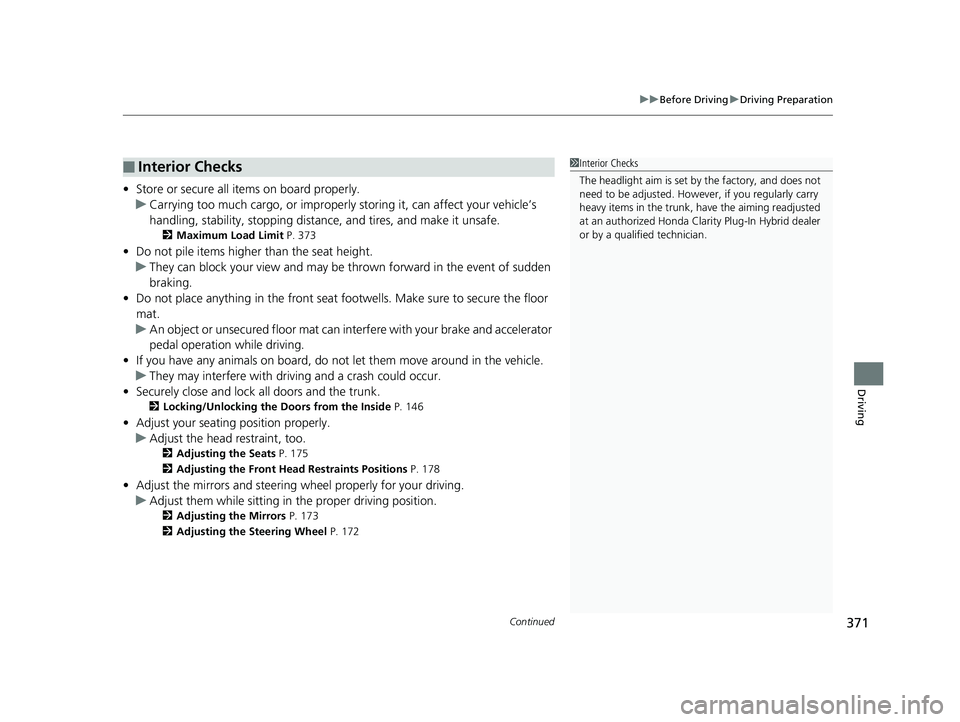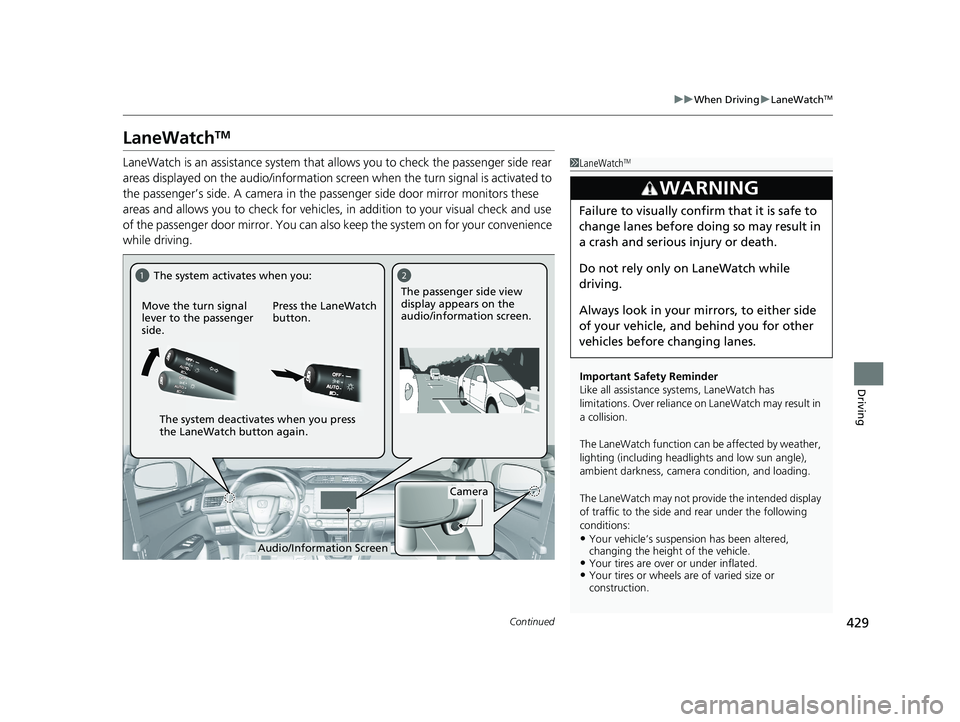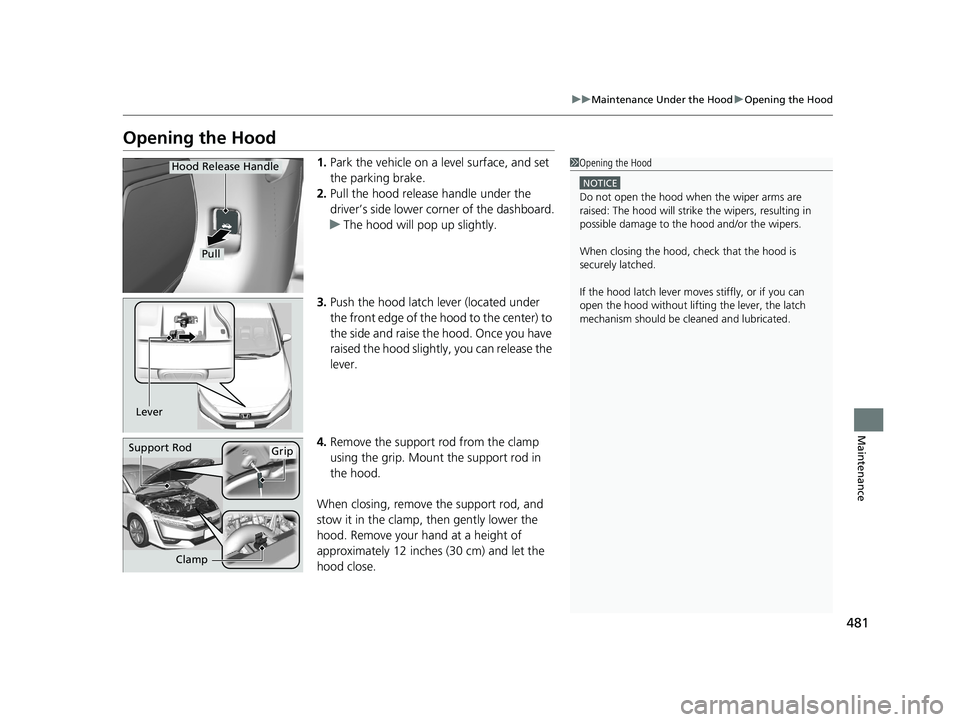Page 181 of 591

179uu Adjusting the Seats u Head Restraints
Controls
A passenger sitting in th e center back seating
position should adjust the height of their head
restraint to an appropriate position before the
vehicle begins moving.
To raise the head restraint:
Pull it upward.
To lower the head restraint:
Push it down while pressing the release
button.
Head restraints can be removed for cleaning or repair.
To remove a head restraint:
Pull the restraint up as far as it will go. Then push the release button, and pull the
restraint up and out.
To reinstall a head restraint:
Insert the legs back in place, then adjust the head restraint to an appropriate height
while pressing the release button. Pull up on the restraint to make sure it is locked
in position.■ Changing the Rear Center Seat Head Restraint Positions
■ Removing and Reinstalling the Head Restraints Front and rear center head restraints
1 Removing and Reinstalling the Head Restraints
3
WARNING Failure to reinstall, or correctly reinstall, the
head restraints can result in severe injury
during a crash.
Always replace the he ad restraints before
driving.18 CLARITY PHEV CSS-31TRW6000.book 179 ページ 2017年8月31日 木曜日 午後2時49分
Page 373 of 591

Continued
371 uu Before Driving u Driving Preparation
Driving
• Store or secure all items on board properly.
u Carrying too much cargo, or improperly storing it, can affect your vehicle’s
handling, stability, sto pping distance, and tires, and make it unsafe.2 Maximum Load Limit P. 373
• Do not pile items higher than the seat height.
u They can block your view and may be thrown forward in the event of sudden
braking.
• Do not place anything in the front seat footwells. Make sure to secure the floor
mat.
u An object or unsecured floor mat can in terfere with your brake and accelerator
pedal operation while driving.
• If you have any animals on board, do not let them move around in the vehicle.
u They may interfere with driv ing and a crash could occur.
• Securely close and lock all doors and the trunk. 2 Locking/Unlocking the Doors from the Inside P. 146
• Adjust your seating position properly.
u Adjust the head restraint, too.2 Adjusting the Seats P. 175
2 Adjusting the Front Head Restraints Positions P. 178
• Adjust the mirrors and steering wh eel properly for your driving.
u Adjust them while sitting in the proper driving position. 2 Adjusting the Mirrors P. 173
2 Adjusting the Steering Wheel P. 172■ Interior Checks 1 Interior Checks
The headlight aim is set by the factory, and does not
need to be adjusted. Howeve r, if you regularly carry
heavy items in the trunk, have the aiming readjusted
at an authorized Honda Clar ity Plug-In Hybrid dealer
or by a qualif ied technician.18 CLARITY PHEV CSS-31TRW6000.book 371 ページ 2017年8月31日 木曜日 午後2時49分
Page 431 of 591

429 uu When Driving u LaneWatch TM
Continued
Driving
LaneWatch TM
LaneWatch is an assistance system that al lows you to check the passenger side rear
areas displayed on the audio/information screen when the turn signal is activated to
the passenger’s side. A camera in the pa ssenger side door mi rror monitors these
areas and allows you to check for vehicles, in addition to your visual check and use
of the passenger door mirror. You can also keep the system on for your convenience
while driving. 1 LaneWatch TM
Important Safety Reminder
Like all assistance systems, LaneWatch has
limitations. Over reliance on LaneWatch may result in
a collision.
The LaneWatch func tion can be affect ed by weather,
lighting (including headli ghts and low sun angle),
ambient darkness, camera condition, and loading.
The LaneWatch may not prov ide the intended display
of traffic to the side a nd rear under the following
conditions:
• Your vehicle’s suspension has been altered,
changing the height of the vehicle.
• Your tires are over or under inflated.
• Your tires or wheels are of varied size or
construction.3
WARNING Failure to visually confirm that it is safe to
change lanes before doing so may result in
a crash and serious injury or death.
Do not rely only on LaneWatch while
driving.
Always look in your mi rrors, to either side
of your vehicle, and behind you for other
vehicles before changing lanes.1 2
CameraMove the turn signal
lever to the passenger
side. Press the LaneWatch
button. The passenger side view
display appears on the
audio/information screen.The system activates when you:
The system deactivates when you press
the LaneWatch button again.
Audio/Information Screen18 CLARITY PHEV CSS-31TRW6000.book 429 ページ 2017年8月31日 木曜日 午後2時49分
Page 447 of 591

445uu Braking u Collision Mitigation Braking System TM
(CMBS TM
)
Continued
Driving
• When there is a group of people in front of your vehicle walking together side by
side.
• Surrounding conditions or belongings of the pedestrian alter the pedestrian’s
shape, preventing the system from recogn izing that the person is a pedestrian.
• When the pedestrian is shorte r than about 3.3 feet (1 me ter) or taller than about
6.6 feet (2 meters) in height.
• When a pedestrian blends in with the background.
• When a pedestrian is bent over or squatting, or when their hands are raised or
they are running.
• When several pedestrians are walking ahead in a group.
• When the camera cannot correctly identify that a pedestrian is present due to an
unusual shape (holding luggage, body position, size).
■ Automatic shutoff
The CMBS TM
may automatically shut itself off and the CMBS TM
indicator comes and
stays on when:
• The temperature inside the system is high.
• You drive off-road or on a mountain road, or curved and winding road for an
extended period.
• An abnormal tire condition is detected (wrong tire size, flat tire, etc.).
• The camera behind the rearview mirror, or the area around the camera, including
the windshield, gets dirty.
Once the conditions th at caused the CMBS TM
to shut off improve or are addressed
(e.g., cleaning), the system comes back on. Limitations applicable to pedestrian detection only18 CLARITY PHEV CSS-31TRW6000.book 445 ページ 2017年8月31日 木曜日 午後2時49分
Page 483 of 591

481uu Maintenance Under the Hood u Opening the Hood
Maintenance
Opening the Hood 1. Park the vehicle on a level surface, and set
the parking brake.
2. Pull the hood release handle under the
driver’s side lower corner of the dashboard.
u The hood will pop up slightly.
3. Push the hood latch lever (located under
the front edge of the hood to the center) to
the side and raise the hood. Once you have
raised the hood slightly , you can release the
lever.
4. Remove the support rod from the clamp
using the grip. Mount the support rod in
the hood.
When closing, remove the support rod, and
stow it in the clamp, then gently lower the
hood. Remove your hand at a height of
approximately 12 inches (30 cm) and let the
hood close. 1 Opening the Hood NOTICE
Do not open the hood when the wiper arms are
raised: The hood will strike the wipers, resulting in
possible damage to the hood and/or the wipers.
When closing the hood, check that the hood is
securely latched.
If the hood latch lever moves stiffly, or if you can
open the hood without lifti ng the lever, the latch
mechanism should be cl eaned and lubricated.PullHood Release Handle
Lever
Support Rod
Grip
Clamp18 CLARITY PHEV CSS-31TRW6000.book 481 ページ 2017年8月31日 木曜日 午後2時49分
Page 502 of 591

500 uu Checking and Maintaining Tires u Tire and Loading Information Label
Maintenance Tire and Loading Information Label The label attached to the driver’s doorj amb provides necessary tire and loading
information.
Tire Labeling The tires that came on your vehicle have a
number of markings. Those you should be
aware of are described as shown.
Whenever tires are replaced, they should be replaced with tires of the same size. 1 Tire and Loading Information Label
The tire and loading informat ion label attached to the
driver’s doorjamb contains: a
The number of people your vehicle can carry. b
The total weight your ve hicle can carry. Do not
exceed this weight. c
The original tire sizes for front, rear, and spare, if
equipped. d
The proper cold tire pre ssure for front, rear, and
spare, if equipped.Label
Example
Example
Tire Size
Tire
Identification
Number (TIN)
Maximum
Tire Load
Maximum
Tire Pressure
Tire Size
■ Tire Sizes 1 Tire Sizes
Following is an example of tire size with an
explanation of what each component means.
235/45R18 94V
235: Tire width in millimeters.
45: Aspect ratio (the tire’s section height as a
percentage of its width).
R: Tire construction code (R indicates radial).
18: Rim diameter in inches.
94: Load index (a numerical code associated with the
maximum load the tire can carry).
V: Speed symbol (an alphab etical code indicating the
maximum speed rating).18 CLARITY PHEV CSS-31TRW6000.book 500 ページ 2017年8月31日 木曜日 午後2時49分